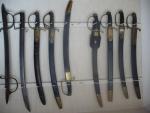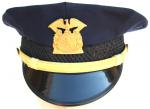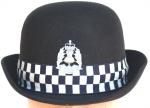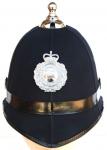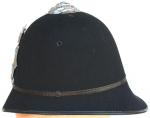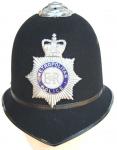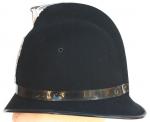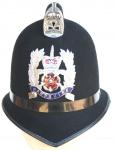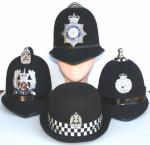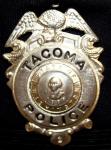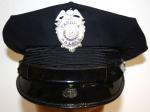-
Posts
13,225 -
Joined
-
Last visited
-
Days Won
22
Content Type
Profiles
Forums
Blogs
Gallery
Events
Store
Everything posted by Mervyn Mitton
-

Seaforth Highlanders Sghian Dubh ~1880's
Mervyn Mitton replied to Hugh's topic in Swords & Edged Weapons
Hi - Hugh. So good to have a new and interesting Scottish item. I think this is the first Skein Dhu ( British spelling) I have seen on edged weapons. I would endorse your dating - is the top gilt or, is it the photography colour ? Unfortunately, they are now forbidden in Britain under new legislation and they wear plastic ones .... The blade is prior to stainless steel so, they do get the black marks from handling. There are a number of compounds on the market and if I were you, I would use one of those - rather than someone's 'patented' recipe. We see quite a number of these and of course, their accompanying dirks. A good military - officer's - dirk, with regt. inscriptions or, badge - can easily fetch up to £2000 ($3000). I will not give a value on yours - unless you would like one for insurance. The handles were usually ebony - or, in some cases bog oak. Yours does not look like ebony as it is brown at the top. Thankyou for a very unusual post. Mervyn -

First Day Cover - Japan Surrenders
Mervyn Mitton replied to bmsm's topic in Coins & Commemorative Medallions
Hi - Bob. Would this have been issued by the United States or, the Phillipines ? Do these items have much value ? Mervyn -

Just a Few QSA's
Mervyn Mitton replied to QSAMIKE's topic in Great Britain: Orders, Gallantry, Campaign Medals
Very impressive, Mike. Some close-ups of a few rarer ones would be good ? -

ASHANTEE MEDAL 1874-1874
Mervyn Mitton replied to a topic in Great Britain: Orders, Gallantry, Campaign Medals
Good addition, Darrell. Always sought after for collections. Leigh - you have good eyesight - I had to go back and look hard........ -

my new military medal!
Mervyn Mitton replied to paddywhack's topic in Great Britain: Orders, Gallantry, Campaign Medals
Great for Paddywhack that you have actually found his picture. How young they all look - trying to be older with 'taches. I wonder how many survived - at least in the Artillery they stood a slightly better chance. -

INTRO.. WORLD POLICE FORCES
Mervyn Mitton replied to Mervyn Mitton's topic in Police Forces of the World
-

PART 1 - POLICE FORCES OF THE WORLD
Mervyn Mitton replied to Mervyn Mitton's topic in Police Forces of the World
Nothing to add at this point - just trying to get them in order. This won't last , so watch dates. -

PART 2 - POLICE FORCES OF THE WORLD
Mervyn Mitton replied to Mervyn Mitton's topic in Police Forces of the World
The badge shows the possible Dutch background of the Town - looks like the Lion from the coat-of-arms ? -

PART 2 - POLICE FORCES OF THE WORLD
Mervyn Mitton replied to Mervyn Mitton's topic in Police Forces of the World
Another version of a US Police cap. This one is a summer issue - thinner in the material and with good ventilation. The badge is for a small town outside of New York - the name escapes me, perhaps someone will recognise it. I exchanged my second helmet with a Sgt. from the Force who was visiting our Station. He was desperate for a British Helmet and I was the only one who would oblige..... I have always understood that a Sgt. in America stands at a higher level then a British Sgt. - has duties more like our Inspectors' ? -

PART 3 - POLICE FORCES OF THE WORLD
Mervyn Mitton replied to Mervyn Mitton's topic in Police Forces of the World
-

PART 3 - POLICE FORCES OF THE WORLD
Mervyn Mitton replied to Mervyn Mitton's topic in Police Forces of the World
The Womens' cap is a standard for all of Britain. The crown has built-in protection. The badges - of course - vary for each Force. This is a standard Scottish one - the badge is the same for all of their Forces. The motto - Semper Vigilo - 'always vigilant' (when not in the canteen, having tea..... only joking, ma'am) -

PART 3 - POLICE FORCES OF THE WORLD
Mervyn Mitton replied to Mervyn Mitton's topic in Police Forces of the World
-

PART 3 - POLICE FORCES OF THE WORLD
Mervyn Mitton replied to Mervyn Mitton's topic in Police Forces of the World
The least popular of the adopted patterns is the 'Ball Top'. In the 19th. century it was quite common for officers' helmets to have a spike - as for the military. This was discontinued as being too dangerous - however, the Ball has been kept. I personally think it is quite elegant and certainly shows-up in a crowd situation. This one has the plate for the County of Devon. -

PART 3 - POLICE FORCES OF THE WORLD
Mervyn Mitton replied to Mervyn Mitton's topic in Police Forces of the World
-

PART 3 - POLICE FORCES OF THE WORLD
Mervyn Mitton replied to Mervyn Mitton's topic in Police Forces of the World
The Bell top is probably the most popular of British helmets. This one is for The Metropolitan Police and shows the current badge. -

PART 3 - POLICE FORCES OF THE WORLD
Mervyn Mitton replied to Mervyn Mitton's topic in Police Forces of the World
-

PART 3 - POLICE FORCES OF THE WORLD
Mervyn Mitton replied to Mervyn Mitton's topic in Police Forces of the World
The Force most commonly associated with the Coxcomb helmet is the City of London. This example is for Hampshire and it is displaying a Sergeant's elaborate helmet plate. -
Probably the most distinctive Police headgear in the World is for the British Helmet. This was originally modelled on the Prussian military headgear of the 1860's - our British Army took the pattern over and in turn, it was adopted by the Metropolitan Police from about 1863. Other Forces also gradually phased out the original Top Hats and over a period of some years it became the standard. However, some Head Constables had strange ideas - Worcester for example had a green helmet and uniform for a short while. The Home Office took control and authorised only three patterns of helmets - these continue to the present day, although the wearing of the helmet is under pressure. The three approved types were the Bell , the Coxcomb and the Ball top. These have been shown previously under British and Commonwealth - however, I think it worthwhile to re-post them under this new ref. heading. I have also included the Womens' Bowler style - although, I believe it has already been re-modelled. Please see the intro. post to see the other information we are hoping to add to each section.
-
Gordon - the quick and easy way to date early Sth. African Police badges is to remember that from 1913 to 1926 the bi-lingual wording for the Afrikaans, was actually in High Dutch. The spelling for 'POLICE' was in fact 'POLITIE' - after 1926 it became 'POLISIE'. After 1960 the British Crown was dropped. I have a number of early badges and will post some examples.
-

my new military medal!
Mervyn Mitton replied to paddywhack's topic in Great Britain: Orders, Gallantry, Campaign Medals
Hi - paddywhack - nice clean example. Rank is put in a way I haven't seen before - Gnr - L.bmdr. Even if he was only an acting L/b not a common way to put it down (at least to me.) I have thought for a long time that the MM is grossly underpriced - there may have been a lot given in WW1 - however, they are still a high award. By the time you are Michael's age - I think you will find it has gone up much higher, so, in my 'book' they are a good investment. -

PART 2 - POLICE FORCES OF THE WORLD
Mervyn Mitton replied to Mervyn Mitton's topic in Police Forces of the World
-

PART 2 - POLICE FORCES OF THE WORLD
Mervyn Mitton replied to Mervyn Mitton's topic in Police Forces of the World
-

PART 2 - POLICE FORCES OF THE WORLD
Mervyn Mitton replied to Mervyn Mitton's topic in Police Forces of the World
-
This second example cap is fairly straight forward for identification - Tacoma in the US. However, please see intro. for other details which will be helpful.
-

PART 1 - POLICE FORCES OF THE WORLD
Mervyn Mitton replied to Mervyn Mitton's topic in Police Forces of the World



